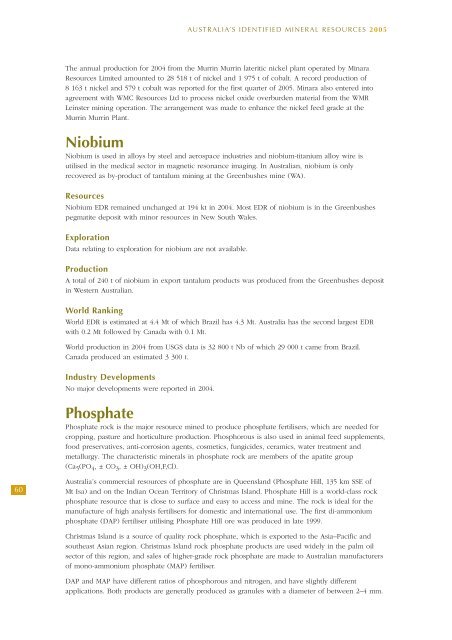australia's identified mineral resources 2005 - Geoscience Australia
australia's identified mineral resources 2005 - Geoscience Australia
australia's identified mineral resources 2005 - Geoscience Australia
Create successful ePaper yourself
Turn your PDF publications into a flip-book with our unique Google optimized e-Paper software.
AUSTRALIA’S IDENTIFIED MINERAL RESOURCES <strong>2005</strong><br />
The annual production for 2004 from the Murrin Murrin lateritic nickel plant operated by Minara<br />
Resources Limited amounted to 28 518 t of nickel and 1 975 t of cobalt. A record production of<br />
8 163 t nickel and 579 t cobalt was reported for the first quarter of <strong>2005</strong>. Minara also entered into<br />
agreement with WMC Resources Ltd to process nickel oxide overburden material from the WMR<br />
Leinster mining operation. The arrangement was made to enhance the nickel feed grade at the<br />
Murrin Murrin Plant.<br />
Niobium<br />
Niobium is used in alloys by steel and aerospace industries and niobium-titanium alloy wire is<br />
utilised in the medical sector in magnetic resonance imaging. In <strong>Australia</strong>n, niobium is only<br />
recovered as by-product of tantalum mining at the Greenbushes mine (WA).<br />
Resources<br />
Niobium EDR remained unchanged at 194 kt in 2004. Most EDR of niobium is in the Greenbushes<br />
pegmatite deposit with minor <strong>resources</strong> in New South Wales.<br />
Exploration<br />
Data relating to exploration for niobium are not available.<br />
Production<br />
A total of 240 t of niobium in export tantalum products was produced from the Greenbushes deposit<br />
in Western <strong>Australia</strong>n.<br />
World Ranking<br />
World EDR is estimated at 4.4 Mt of which Brazil has 4.3 Mt. <strong>Australia</strong> has the second largest EDR<br />
with 0.2 Mt followed by Canada with 0.1 Mt.<br />
World production in 2004 from USGS data is 32 800 t Nb of which 29 000 t came from Brazil.<br />
Canada produced an estimated 3 300 t.<br />
Industry Developments<br />
No major developments were reported in 2004.<br />
Phosphate<br />
Phosphate rock is the major resource mined to produce phosphate fertilisers, which are needed for<br />
cropping, pasture and horticulture production. Phosphorous is also used in animal feed supplements,<br />
food preservatives, anti-corrosion agents, cosmetics, fungicides, ceramics, water treatment and<br />
metallurgy. The characteristic <strong>mineral</strong>s in phosphate rock are members of the apatite group<br />
(Ca 5 (PO 4 , ± CO 3 , ± OH) 3 (OH,F,Cl).<br />
60<br />
<strong>Australia</strong>’s commercial <strong>resources</strong> of phosphate are in Queensland (Phosphate Hill, 135 km SSE of<br />
Mt Isa) and on the Indian Ocean Territory of Christmas Island. Phosphate Hill is a world-class rock<br />
phosphate resource that is close to surface and easy to access and mine. The rock is ideal for the<br />
manufacture of high analysis fertilisers for domestic and international use. The first di-ammonium<br />
phosphate (DAP) fertiliser utilising Phosphate Hill ore was produced in late 1999.<br />
Christmas Island is a source of quality rock phosphate, which is exported to the Asia–Pacific and<br />
southeast Asian region. Christmas Island rock phosphate products are used widely in the palm oil<br />
sector of this region, and sales of higher-grade rock phosphate are made to <strong>Australia</strong>n manufacturers<br />
of mono-ammonium phosphate (MAP) fertiliser.<br />
DAP and MAP have different ratios of phosphorous and nitrogen, and have slightly different<br />
applications. Both products are generally produced as granules with a diameter of between 2–4 mm.

















